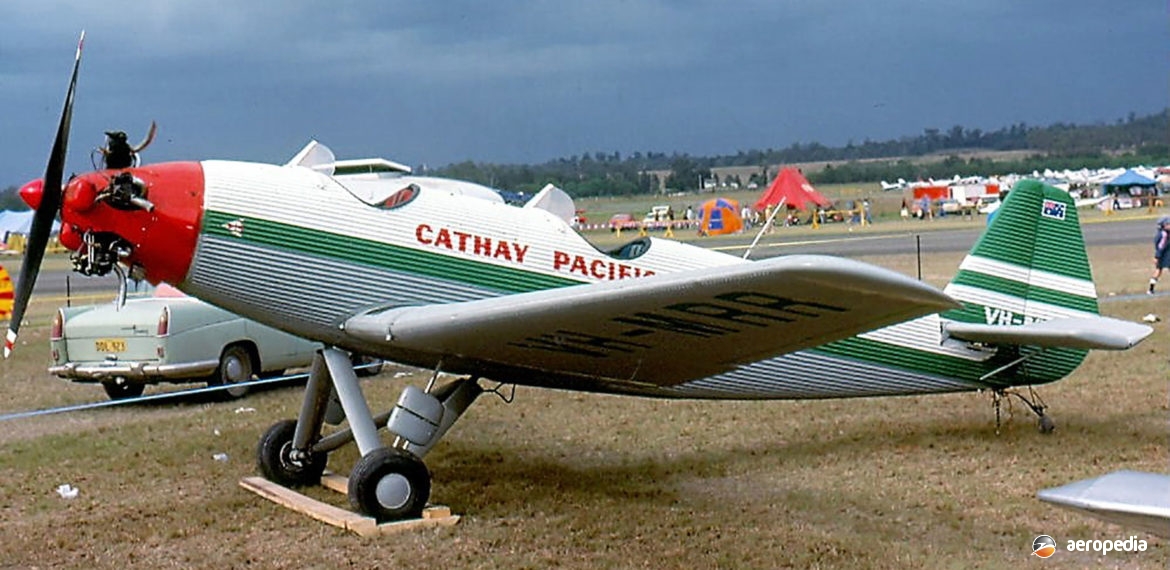Photograph:
Junkers A 50 VH-MRR (c/n 3517) at the Australian Bicentennial Air Show at RAAF Richmond, NSW in October 1988 (David C Eyre)
Country of origin:
Germany
Description:
Two-seat training monoplane
Power Plant:
One 60 kw (80 hp) Armstrong Siddeley Genet Mk 2 five-cylinder air-cooled radial engine
Specifications:
- Wingspan: 10 m (32 ft 10 in)
- Length: 7.12 m (23 ft 6 in)
- Height: 2.41 m (7 ft 11 in)
- Wing area: 13.75 m² (148 sq ft)
- Max speed: 175 km/h (109 mph)
- Cruising speed: 140 km/h (87 mph)
- Landing speed: 74 km/h (46 mph)
- Time to climb to 1,000 m (3,280 ft): 5.5 mins
- Time to climb to 3,000 m (9,840 ft): 21 mins
- Service ceiling: 3,810 m (12,500 ft)
- Range: 600 km (373 miles) or 4 hrs
- Empty weight: 360 kg (794 lb)
- Disposable load: 250 kg (550 lb)
- Loaded weight: 600 kg (1,323 lb)
History:
The prototype of the Junkers A 50 Junior tandem two-seat, all-metal, light monoplane was flown for the first time in 1928. Featuring typical Junkers construction of the period, which proved very durable, the Junkers concern already had quite a number of aircraft models operating in the Australasian region with similar construction but which were much larger aircraft overall. Junkers aircraft in Australia have included the F 13, G 31, W 33, W 34, Ju 52, etc, all large transports which served faithfully in the highlands of Papua New Guinea.
The A 50 used similar construction to the larger transports, although it was quite a small aircraft. The wing had four spars with corrugated metal skinning to provide torsional strength; in fact the corrugated metal covering was one of the A-50’s distinguishing features. A-50s could be powered by either the seven-cylinder Siemens Halske SH-132 engine of 60 kw (80 hp) or the five-cylinder Genet radial of similar power.
One aircraft VH-MRR (c/n 3517) has survived. Originally registered VH-UCC to P T Parker of Warrnambool, VIC on 2 March 1936, the Certificate of Airworthiness lapsed and it was withdrawn from use on 4 August 1949. It was later registered to F Betts of Belmont, VIC on 12 June 1951, ownership being transferred to Schutt Aircraft Sales & Service of Cheltenham, VIC in April 1953. At one stage it carried the name ‘Rena’. It was registered to A C Mason of East Gippsland, VIC on 7 August 1953, and R J Helps of Windsor, NSW on 20 August 1954, being based at Bankstown, NSW. It was withdrawn from use on 30 June 1959 and underwent reconstruction.
VH-UCC was taken to a property in Lower Portland but was unable to operate from the airstrip then available. It later was registered as VH-MRR, as its old registration, which had lapsed, had been allotted to a Cessna Citation. It was then painted in the colour of Cathay Pacific Airlines. In 2001 it again took up its VH-UCC registration, after the Citation was exported, and underwent some restoration. It was sold to a private owner in Germany and taken to the Hugo Junkers Museum at Dessau in Saxony where it has been undergoing restoration to fly.
A second A 50 VH-UNO (c/n 3507) was also imported, this being a demonstrator for the importers, being registered to H J Berryman of Caulfield, VIC on 17 March 1930. The Certificate of Airworthiness was issued on 5 March that year and it was named ‘Wendouree’. On 5 July 1930, flown by Goya Henry and Arthur Lumb, it left Mascot, NSW for Brisbane, QLD. However, at Broken Bay, just north of Sydney, NSW, it ran into bad weather and turned back. A forced landing was attempted near Manly, NSW but the aircraft collided with a fence, the passenger Lumb being killed and Goya Henry sustaining injuries which necessitated the amputation of a leg. The aircraft was written off.
Although quite a popular aircraft in Europe before World War II, only a few survive today, a couple being airworthy. One has been placed on display in the International Terminal at Helsinki Airport in Finland. This aircraft (c/n 3530) had previously operated as SK-1, OH-ABB, OH-SKY and D-1915 before being retired. Another (c/n 3575) has survived at the Deutsches Museum, Munich, having previously operated in Switzerland as HB-UXI, CH-358 and D-2054.

